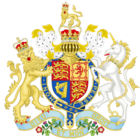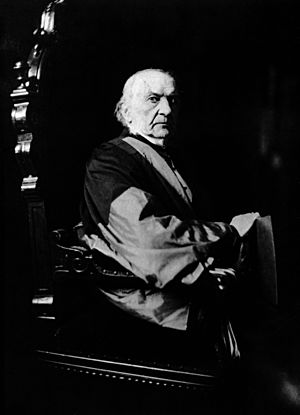Protection of Persons and Property (Ireland) Act 1881 facts for kids
| Act of Parliament | |

|
|
| Long title | An Act for the better Protection of Person and Property in Ireland. |
|---|---|
| Citation | 44 & 45 Vict. c. 4 |
| Introduced by | William Ewart Gladstone, Prime Minister, 24 January 1881 |
| Territorial extent | Kingdom of Ireland |
Quick facts for kids Dates |
|
| Royal assent | 2 March 1881 |
| Repealed | 25 August 1894 |
| Other legislation | |
| Repealed by | Statute Law Revision Act 1894 |
|
Status: Repealed
|
|

The Protection of Persons and Property (Ireland) Act was a law passed in 1881. It was also known as the Coercion Act. This law allowed the government to arrest and hold people in Ireland without a trial. They could do this if they suspected someone was involved in the Land War. The Land War was a time of conflict over land ownership and rents in Ireland.
The Lord Lieutenant of Ireland, a high-ranking official, could announce this law in any part of Ireland. Lists of people arrested under this act had to be shown to the British Parliament.
Contents
Why the Act Was Passed
The 1881 act was one of many "Coercion Acts" used in Ireland under the Union. These laws aimed to control unrest and maintain order. William Ewart Gladstone became Prime Minister again in 1880. At this time, there was a lot of violence and trouble over land in Ireland. This period was known as the Land War.
William Edward Forster was chosen as the Chief Secretary for Ireland. He tried to pass a law to help farmers, but it was rejected. So, on January 24, 1881, he introduced this new Coercion Bill.
Strong Opposition to the Bill
The Irish Parliamentary Party (IPP) strongly opposed the new bill. They used a tactic called filibustering. This means they talked for a very long time to delay the vote. They debated the bill for 41 hours straight!
Eventually, the Speaker of the House of Commons had to step in. He stopped allowing IPP members to speak and called for a vote. This was a very unusual move. Soon after, new rules were made to allow for "cloture" or "guillotine" motions. These rules let the government cut short debates.
After the bill became law in March, it had taken up most of the Parliament's time. One newspaper noted it had "occupied the whole time of the Lower House for seven weeks and a day."
How the Act Was Used
A total of 953 people were arrested under this act. Many of them were active members of the Irish National Land League. This group worked for farmers' rights. Being part of this group was enough reason for "reasonable suspicion" under the law.
On October 13, 1881, the leader of the IPP, Charles Stewart Parnell, was arrested. His newspaper, United Ireland, had criticized another law about land. Parnell was accused of encouraging people not to pay their rents. He was held in Kilmainham Gaol, a prison.
After Parnell's arrest, United Ireland published a "No Rent Manifesto." This urged people not to pay rent. The Land League was then banned. However, it soon reappeared under a new name, the Irish National League. Some Irish Americans with U.S. citizenship were also arrested. This caused a disagreement between the British and American governments.
Ending the Act
The Coercion Act was set to end on September 30, 1882. A bill to cancel it earlier was defeated in February 1882. William Edward Forster wanted to keep the act going forever. But the rest of the government disagreed.
They started talks with Charles Stewart Parnell. These talks led to the "Kilmainham Treaty." As a result, the act was allowed to end. Both Forster and the Lord Lieutenant, John Spencer, 5th Earl Spencer, resigned in May 1882.
The act was officially cancelled later by the Statute Law Revision Act 1894.
Images for kids


